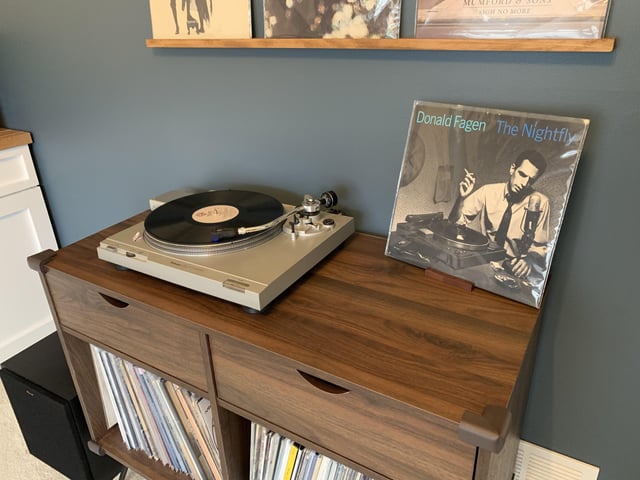In his 1982 solo debut, “The Nightfly”, Donald Fagen invites listeners into a world suspended between nostalgia and dread, where the American dream meets its disillusioned counterpoint. Among the album’s standout tracks is “The Goodbye Look”, a song that combines tropical rhythms with Fagen’s signature irony, painting a portrait of escape and cultural dissonance. In “The Goodbye Look”, Fagen masterfully encapsulates the tension of Cold War anxieties and postcolonial escapism, all set to a melody that feels as breezy as the setting sun over the Caribbean.
To appreciate “The Goodbye Look”, it’s essential to understand the thematic heart of “The Nightfly”, The album, conceived as Fagen’s ode to a bygone era, channels the optimism and underlying fears of the late 1950s and early 1960s. With each track, Fagen explores the tension between idealism and reality, wrapping cultural memory in layers of irony.
“The Goodbye Look” takes place in an idyllic, tropical paradise on the verge of collapse—an idealized retreat for the protagonist but one shadowed by the specter of revolution. In capturing this fragile setting, Fagen taps into a rich legacy of American cultural fascination with exotic locales, while simultaneously critiquing the Western notion of paradise as an escape from domestic realities. This island, unnamed yet palpable, serves as a microcosm for Cold War disillusionment and personal crisis, making “The Goodbye Look” both a critique of escapism and an eerie foreshadowing of instability.
Musically, “The Goodbye Look” is as layered as its narrative, blending jazz, rock, and Latin influences in a deceptively breezy composition. Fagen’s meticulous arrangement incorporates rhythmic congas, smooth chords, and the sunny timbre of steel drums, creating an easygoing vibe that juxtaposes the protagonist’s anxiety. Fagen’s knack for irony is evident in this contrast: he evokes a relaxed, touristy soundscape only to undercut it with lyrics that hint at danger and discomfort.
The production quality, characteristic of Fagen’s approach, is pristine and clear, a signature of The Nightfly’s sound. This polished production not only elevates the song’s layered instrumentation but reinforces the protagonist’s desire to maintain a “cool” exterior as he confronts chaos. Fagen’s use of these production techniques emphasizes how deeply embedded the narrative is within the music itself. The lightness of the melody lulls listeners in, making the moment of realization about the protagonist’s plight even sharper.
One of Fagen’s great talents as a songwriter is his ability to craft characters that feel both specific and universal. In “The Goodbye Look”, Fagen’s protagonist is a cynical expatriate—a “man out of time” who has arrived in paradise only to witness its unraveling. Through clever, occasionally sardonic lines, Fagen conveys the protagonist’s discomfort with his surroundings, blending sharp observations with a detached sense of humor.
Fagen’s narrative perspective here is distinctly postcolonial, drawing on the image of the privileged outsider who has come to paradise only to find himself unwelcome and ill-prepared for the turmoil he’s witnessing. The titular “goodbye look” is more than just a gesture; it’s an acknowledgment of his own displacement and vulnerability. This theme of the “outsider” resonates with American listeners who, during the Cold War era, may have felt a similar anxiety about the broader world and their nation’s place within it.
While the music is light, Fagen’s lyrics are anything but. As the protagonist observes the simmering tensions around him, his casual tone belies a deeper fear. Lines like “I wonder if they’ll think of me,” and “Will they shut me out or welcome me with open arms?” capture a dissonance familiar to those who have sought escape, only to realize that paradise is not exempt from danger.
In these lyrics, Fagen subtly weaves the political undertones of the Cold War. The protagonist’s desire to evade conflict mirrors America’s own attempts to maintain an image of stability despite growing global tensions. The tropical setting serves as a metaphor for the illusions of safety and isolation that permeated the American mindset during the 1960s, as the nation sought comfort in a world marked by increasing uncertainty.
“The Goodbye Look” also prompts listeners to reflect on the Western fascination with “exotic” locations as sites of escape. Fagen’s protagonist is not merely visiting a paradise; he embodies the attitude of a tourist looking to remain insulated from the struggles that define the locals’ experience. This detachment highlights a common Western view of tropical locales as escape routes rather than complex societies with their own challenges and histories.
While Fagen avoids heavy-handedness, his portrayal of the tropical setting as simultaneously alluring and perilous serves as a critique of this attitude. By underlining the protagonist’s awareness of revolution, he suggests a world in which the Western notion of paradise is not just escapism but a lens that distorts reality. This exploration of exoticism and colonialism feels particularly resonant in today’s globalized world, where cultural exchanges often come with uneven power dynamics.
“The Goodbye Look” stands as a testament to Fagen’s ability to marry musical complexity with social commentary, a skill he perfected as part of Steely Dan. The track has influenced a generation of musicians drawn to the fusion of jazz, rock, and cultural critique. By presenting the story of a world-weary traveler in paradise, Fagen captures an archetype that resonates well beyond its Cold War origins.
In today’s world, where political instability and climate change continue to affect once-pristine locations, “The Goodbye Look”feels more relevant than ever. The protagonist’s sense of dread, masked by his outward calm, mirrors modern concerns about the state of the world. This lingering sense of escapism tempered by disillusionment speaks to the heart of Fagen’s work, making “The Goodbye Look” a classic that remains poignant across generations.
No comments yet.








